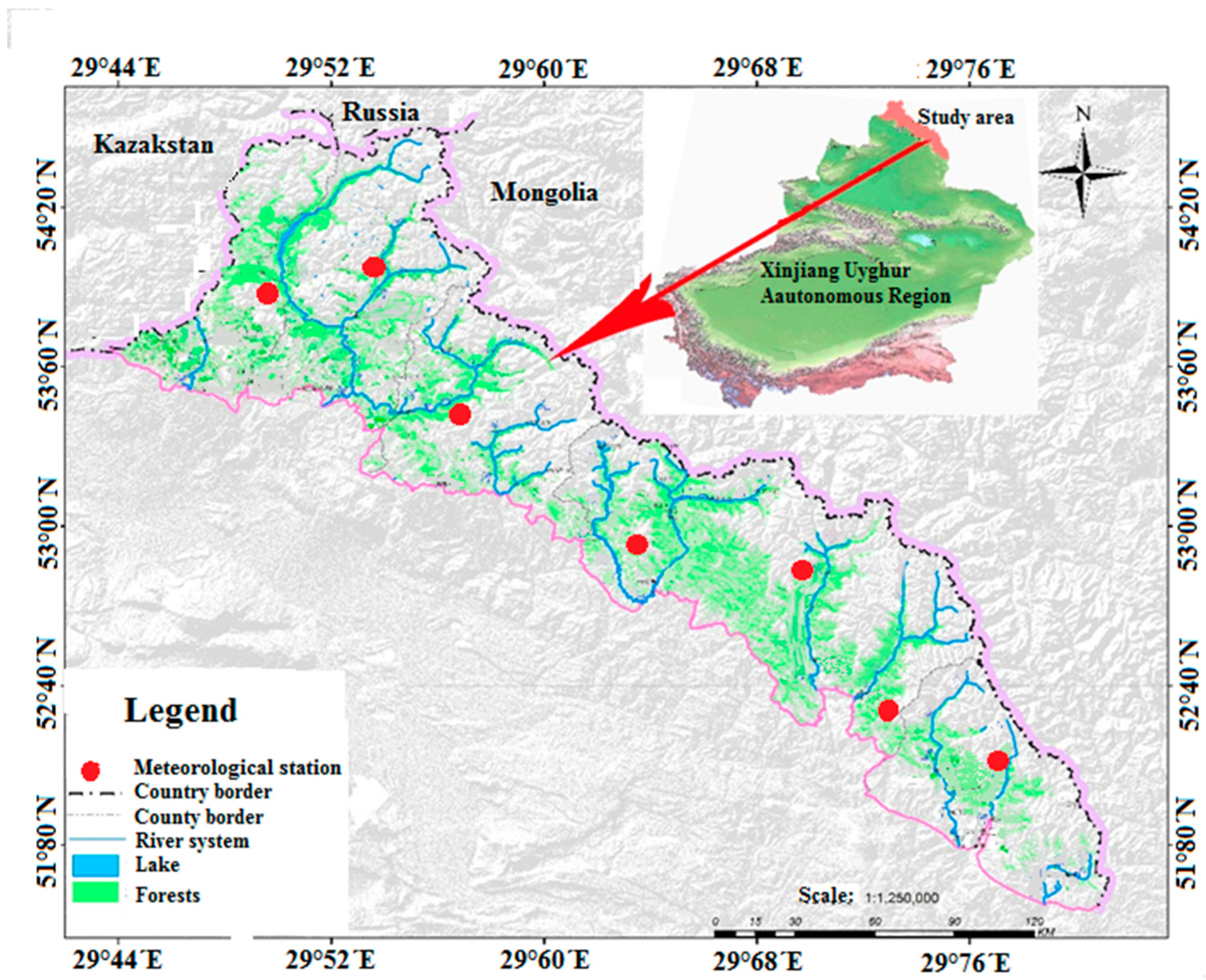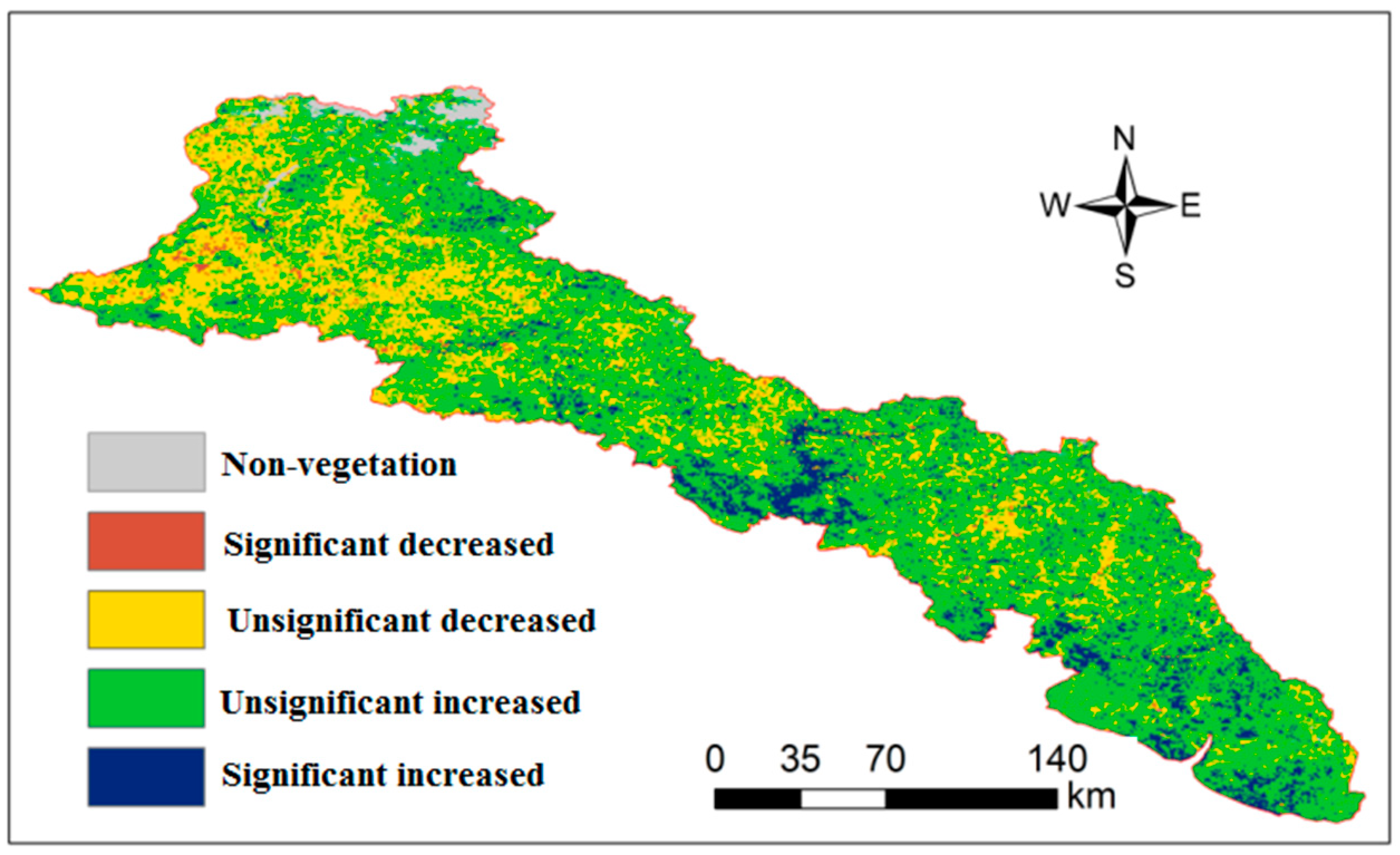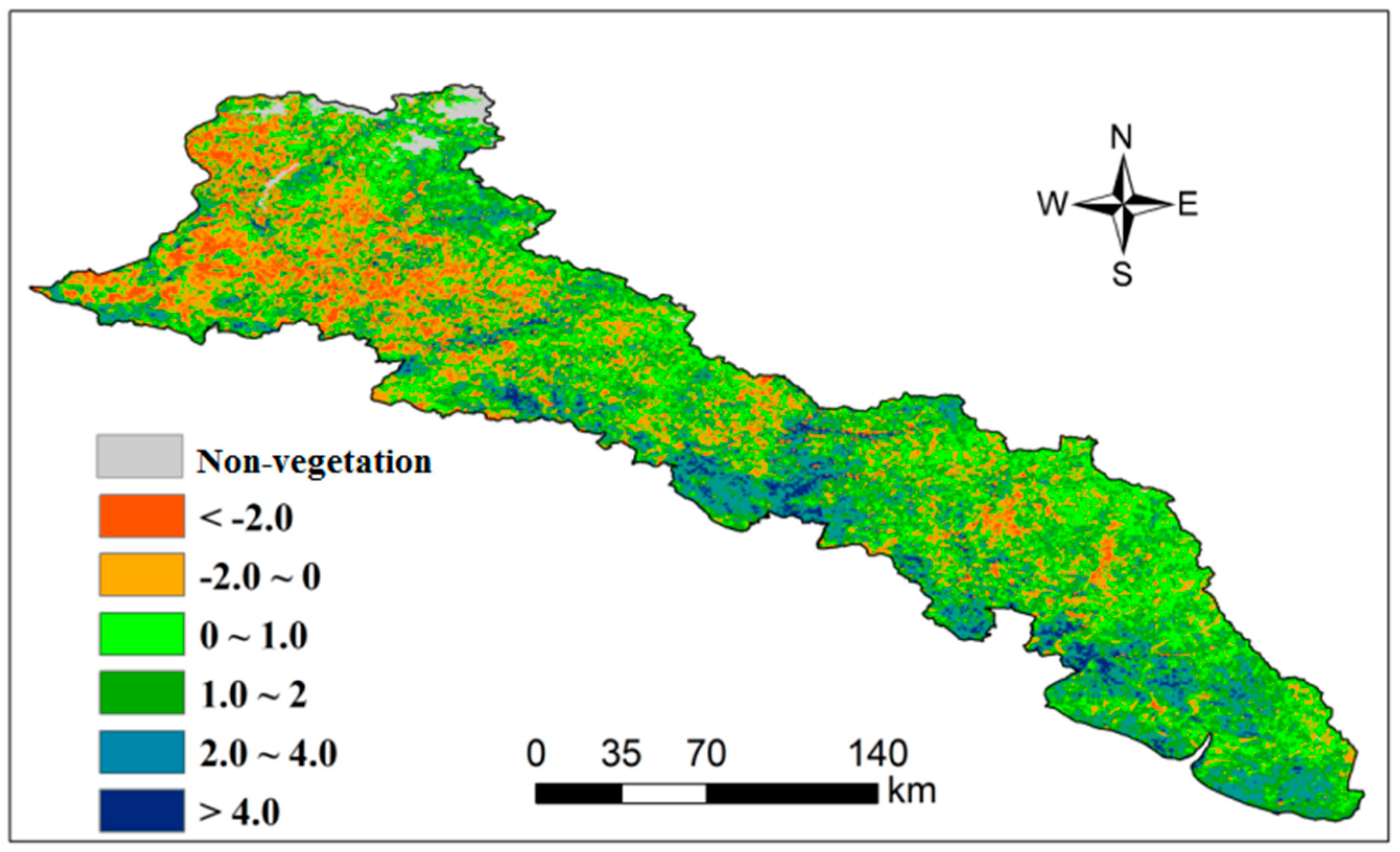Dynamics of Vegetation Productivity in Relation to Surface Meteorological Factors in the Altay Mountains in Northwest China
Abstract
1. Introduction
2. Material and Methods
2.1. Description of Study Area
2.2. Data Sources
2.3. Statistical Methods
2.3.1. Climate Tendency Method
2.3.2. Correlation Analysis
2.3.3. GPP Inversion of Total Primary Productivity
3. Results and Discussions
3.1. General Characteristics of Vegetation Productivity in the Altay Mountains
3.2. Annual Variation of Vegetation Productivity in the Altay Mountains
3.3. Impact of Meteorological Factors on Vegetation GPP
4. Conclusions
Author Contributions
Funding
Data Availability Statement
Acknowledgments
Conflicts of Interest
References
- Evans, J.; Geerken, R. Discrimination between climate and human-induced dryland degradation. J. Arid Environ. 2004, 57, 535–554. [Google Scholar] [CrossRef]
- Supannika, P.; Yoshifumi, Y. Application of the 3-PG Model for Gross Primary Productivity Estimation in Deciduous Broadleaf Forests: A Study Area in Japan. Forests 2011, 2, 590–609. [Google Scholar]
- Wan, J.Z.; Yum, J.H.; Yin, G.J.; Song, Z.M.; Wei, D.X.; Wang, C.J. Effects of soil properties on the spatial distribution of forest vegetation across China. Glob. Ecol. Conserv. 2019, 1, 635. [Google Scholar] [CrossRef]
- He, Z.; Zhao, W.; Zhang, L.; Liu, H. Response of tree recruitment to climatic variability in the Alpine treeline ecotone of the Qilian Mountains, northwestern China. Forest Sci. 2013, 59, 118–126. [Google Scholar] [CrossRef]
- Urbanov, A.M.; Snajdr, J.; Baldrian, P. Composition of fungal and bacterial communities in forest litter and soil is largely determined by dominant trees. Soil Biol. Biochem. 2015, 84, 53–64. [Google Scholar] [CrossRef]
- Wang, Y.; Yan, X.D. The response of the forest ecosystem in China to global climate change. Chin. J. Atmos. Sci. 2006, 30, 1009–1018. (In Chinese) [Google Scholar]
- Molina, A.J.; Llorens, P.; Garcia-Estringana, P.; Heras, M.M.; Cayuela, C.; Gallart, F.; Latron, J. Contributions of throughfall, forest and soil characteristics to near-surface soil water-content variability at the plot scale in a mountainous Mediterranean area. Sci. Total Environ. 2019, 647, 1421–1432. [Google Scholar] [CrossRef]
- Melissa, M.; Kreye, D.; Adams, C.; Francisco, J.E. The Value of Forest Conservation for Water Quality Protection. Forests 2014, 5, 862–884. [Google Scholar]
- Lin, W.C.; Lin, Y.P.; Lien, W.Y.; Wang, Y.C.; Lin, C.T.; Chiou, C.R.; Johnathen, A.; Neville, D.C. Expansion of Protected Areas under Climate Change: An Example of Mountainous Tree Species in Taiwan. Forests 2014, 5, 2882–2904. [Google Scholar] [CrossRef]
- Yu, S. A review on the impact of climate change on forest tree mortality. Protect. Forest Sci. Technol. 2014, 12, 67–69. [Google Scholar]
- Trindade, W.C.F.; Santos, M.H.; Artoni, R.F. Climate change shifts the distribution of vegetation types in South Brazilian hotspots. Reg. Environ. Chang. 2020, 20, 90. [Google Scholar] [CrossRef]
- Palombo, C.; Chirici, G.; Marchetti, M.; Tognetti, R. Island abandonment affecting forest dynamics at high elevation in Mediterranean mountains more than climate change? Plant Biosyst. 2013, 147, 1–11. [Google Scholar] [CrossRef]
- Aishajiang, A.; Xu, H.L.; Yuan, K.Y. Assessment of the effects of artificial restoration measures in abandoned gold mining area in Altay Mountains using PCA and monitoring data. Arid Land Geog. 2019, 42, 288–294. (In Chinese) [Google Scholar]
- Xu, F.J.; Xu, H.L.; Aleta, I.T. Study on the Integration and Model of Mining Area Restoration Technology in Altay Area; China Forestry Press: Beijing, China, 2019. (In Chinese) [Google Scholar]
- Jian, N. Forest productivity of the Altay and Tianshan Mountains in the dryland, northwestern China. Forest Ecol. Manag. 2004, 202, 13–22. [Google Scholar]
- Cheng, F.; Yuan, Y.J.; Wei, W.S.; Zhang, T.W.; Shang, H.M.; Zhang, R.B. Precipitation reconstruction for the southern Altay Mountains (China) from tree rings of Siberian spruce, reveals recent wetting trend. Dendrochronologia 2014, 32, 266–272. [Google Scholar] [CrossRef]
- Sohngen, B.; Mendelsohn, R.; Sedjo, R. A global model of climate change impacts on timber markets. J. Agric. Res. Econ. 2001, 26, 326–343. [Google Scholar]
- Boisvenue, C.; Running, S.W. Impacts of climate change on natural forest productivity-evidence since the middle of the 20th century. Glob. Chang. Biol. 2006, 12, 862–882. [Google Scholar] [CrossRef]
- Jiang, F.Q.; Yu, Z.Y.; Zeng, D.H. Impact of climate change on the Three-north Shelter Forest Program and corresponding. Chin. J. Ecol. 2009, 28, 1702–1705. (In Chinese) [Google Scholar]
- Castedo-Dorado, F.; Gómez-García, E.; Diéguez-Aranda, U.; Barrio-Anta, M.; Crecente-Campo, F. Aboveground stand-level biomass estimation: A comparison of two methods for major forest species in northwest Spain. Ann. Forest Sci. 2012, 69, 735–746. [Google Scholar] [CrossRef]
- Harrison, W.C.; Daniels, R.F. A New Biomathematical Model for Growth and Yield of Loblolly Pine Plantations. In USDA Forest Service General Technical Report NC-North Central Forest Experiment Station (USA); USDA Forest Service: Washington, DC, USA, 1988. [Google Scholar]
- Qin, J.; Cao, Q.V. Using disaggregation to link individual-tree and whole-stand growth models. Can. J. Forest Res. 2006, 36, 953–960. [Google Scholar] [CrossRef]
- Cheng, X.X.; Yan, X.D. Effects of climate change on typical forest in the Northeast of China. Acta Ecol. Sin. 2008, 28, 534–543. (In Chinese) [Google Scholar]
- Li, J.Q.; Li, Z.Y.; Yi, H.R. Interaction relation between forest and global climate change J. Northwest Forest Univ. 2010, 25, 23–28. (In Chinese) [Google Scholar]
- Zhao, F.Y.; Wang, M.Y.; Shu, L.F. Progress of studies on influences of climate change on forest fire regime. Adv. Clim. Chang. Res. 2009, 5, 50–55. (In Chinese) [Google Scholar]
- Zhou, L.M.; Tucker, C.J.; Kaufmann, R.K. Variations in northern vegetation activity inferred from satellite data of vegetation index during 1981 to 1999. J. Geophys. Res.-Atmos. 2001, 106, 20069–20083. (In Chinese) [Google Scholar] [CrossRef]
- Wang, Y.Y. Temporal and Spatial Variation of Vegetation Phenology in Temperate China and Its Influence on GPP Based on MODIS Data. Master’s Dissertation, Hebei Normal University, Shijiazhuang, China, 2011. (In Chinese). [Google Scholar]
- Yu, X.Z. Dark Respiration Characteristics of Forest and Its Influence on the Estimation of GPP in Ecosystem—A Case Study of Broad-Leaved Korean Pine Forest in Changbai Mountain. Master’s Dissertation, University of Chinese Academy of Sciences, Beijing, China, 2011. (In Chinese). [Google Scholar]
- Barber, V.A.; Juday, G.P.; Finney, B.P. Reduced growth of Alaskan white spruce in the twentieth century from temperature-induced drought stress. Nature 2000, 405, 668–673. [Google Scholar] [CrossRef]
- Giardina, C.P.; Ryan, M.G. Evidence that decomposition rates of organic carbon in mineral soil do not vary with temperature. Nature 2000, 404, 858–861. [Google Scholar] [CrossRef] [PubMed]
- Clark, D.A.; Piper, S.C.; Keeling, C.D. Tropical rain forest tree growth and atmospheric carbon dynamics linked to interannual temperature variation during 1984-2000. Proc. Natl. Acad. Sci. USA 2003, 100, 5852–5857. [Google Scholar] [CrossRef]
- Cao, M.K.; Prince, S.D.; Small, J. Remotely sensed interannual variations and trends in terrestrial net primary productivity 1981 to 2000. Ecosystems 2004, 7, 233–242. [Google Scholar] [CrossRef]
- Yang, H.F.; Gang, C.C.; Mu, S.J. Analysis of the spatio-temporal in net primary productivity of grassland during the past 10 years in Xinjiang. Acta Prataculturae Sin. 2014, 23, 39–50. (In Chinese) [Google Scholar]
- Tan, B.W.; Luo, Z.L. Natural forest protection and forest ecological benefits in Xinjiang. Henan Agric. 2017, 28, 37–41. (In Chinese) [Google Scholar]
- Zheng, S.L.; Xu, W.Q.; Yang, L. Carbon density and storage of forest ecosystem in Altay Mountain, Xinjiang. J. Nat. Res 2016, 31, 1553–1663. (In Chinese) [Google Scholar]
- Ricardo, J.; Morgado, -D. Savitzky–Golay filtering as image noise reduction with sharp color reset. Microprocess. Microsyst. 2020, 74, 103006. [Google Scholar]
- Alberto, F.; Pilar, L.; Jose Luis, C. Automatic mapping of surfaces affected by forest fires in Spain using AVHRR NDVI composite image data. Remote Sens. Environ. 1997, 60, 153–162. [Google Scholar]
- Intergovernmental Panel on Climate Change. Climate Change 2007: Synthesis Report, Text, 2008; Geneva, Switzerland. Available online: https://digital.library.unt.edu/ark:/67531/metadc29351/ (accessed on 11 May 2022).
- Parmesan, C.; Yohe, G. A globally coherent fingerprint of climate change impacts across natural systems. Nature 2003, 421, 37–42. [Google Scholar] [CrossRef] [PubMed]
- Hirota, M.; Nobre, C.; Oyama, M.D. The climatic sensitivity of the forest, savanna and forest-savanna transition in tropical South America. New Phytol. 2010, 187, 707–719. [Google Scholar] [CrossRef]
- Liu, S.R.; Guo, Q.S.; Wang, B. Prediction of net primary productivity of forests in China in response to climate change. Acta Ecol. Sin. 1998, 16, 32–37. (In Chinese) [Google Scholar]
- Du, J.S.; Yu, D.Y. Impacts of climate change and human activities on net primary productivity of grassland in agro-pastoral transitional zone in northern China. J. Beijing Norm. Univ. (Nat. Sci.) 2018, 54, 365–372. (In Chinese) [Google Scholar]
- Wang, Y.H.; Zhou, G.S. Responses of temporal dynamics of aboveground net primary productivity of Leymus chinensis community to precipitation fluctuation in Inner Mongolia. Acta Ecol. Sin. 2004, 24, 1140–1145. (In Chinese) [Google Scholar]
- Yang, F.Q.; Geng, X.X.; Wang, R.; Zhang, Z.X.; Guo, X.J.A. synthesis of mineralization styles and geodynamic settings of the Paleozoic and Mesozoic metallic ore deposits in the Altay Mountains, NW China. J. Asian Earth Sci. 2018, 159, 233–258. [Google Scholar] [CrossRef]
- Kathleen, S. MODIS Cloud Mask User’s Guide. 2011. Available online: https://modis-images.gsfc.nasa.gov/_docs/CMUSERSGUIDE.pdf (accessed on 23 January 2022).
- Du, J.; He, Z.B.; Piatek, K.B.; Chen, L.F.; Lin, P.F.; Zhu, X. Interacting effects of temperature and precipitation on climatic sensitivity of spring vegetation green-up in arid mountains of China. Agric. Forest Meteorol. 2019, 269, 71–77. [Google Scholar] [CrossRef]
- Benjamin, P.; Neil, P.; Liu, H.Y.; Zhu, Z.C.; Rosanne, D.A.; Philippe, C.; Nicole, D.; David, F.; Caroline, L.; Ranga, M.; et al. Recent trends in Inner Asian forest dynamics to temperature and precipitation indicate high sensitivity to climate change. Agric. Forest Meteorol. 2013, 178, 31–45. [Google Scholar]
- Wang, R.J.; Zhang, J.F.; Zhang, D.S.; Dong, L.S.; Qin, G.H.; Wang, S.F. Impacts of climate change on forest growth in saline-alkali land of Yellow River Delta, North China. Dendrochronologia 2022, 74, 125975. [Google Scholar] [CrossRef]







| Period | GPP (g c·m−2) | ||||
|---|---|---|---|---|---|
| <100 | 100~200 | 200~400 | 400~600 | >600 | |
| Annual (%) | 6.17 | 9.18 | 29.21 | 41.10 | 14.34 |
| Growing season (%) | 6.28 | 9.26 | 29.96 | 40.88 | 13.62 |
| April | May | June | July | August | September | ||||||
|---|---|---|---|---|---|---|---|---|---|---|---|
| GPP/g c·m−2 | Proportion/% | GPP/g c·m−2 | Proportion/% | GPP/g c·m−2 | Proportion/% | GPP/g c·m−2 | Proportion/% | GPP/g c·m−2 | Proportion/% | GPP/g c·m−2 | Proportion/% |
| <1 | 4.2 | <10 | 17.27 | <50 | 18.23 | <50 | 8.75 | <25 | 5.51 | <10 | 9.46 |
| 1~5 | 36.73 | 10~40 | 10.95 | 50~100 | 20.72 | 50~100 | 18.98 | 25~50 | 10.83 | 10~20 | 14.04 |
| 5~10 | 18.37 | 40~80 | 31.19 | 100~150 | 32.58 | 100~150 | 36.15 | 50~100 | 49.48 | 20~40 | 51.38 |
| 10~15 | 24.42 | 80~120 | 39.04 | 150~200 | 20.29 | 150~200 | 28.88 | 100~150 | 31.61 | 40~60 | 24.47 |
| >15 | 16.27 | >120 | 1.55 | >200 | 8.18 | >200 | 7.25 | >150 | 2.57 | >60 | 0.65 |
Publisher’s Note: MDPI stays neutral with regard to jurisdictional claims in published maps and institutional affiliations. |
© 2022 by the authors. Licensee MDPI, Basel, Switzerland. This article is an open access article distributed under the terms and conditions of the Creative Commons Attribution (CC BY) license (https://creativecommons.org/licenses/by/4.0/).
Share and Cite
Aili, A.; Xu, H.; Zhao, X.; Zhang, P.; Yang, R. Dynamics of Vegetation Productivity in Relation to Surface Meteorological Factors in the Altay Mountains in Northwest China. Forests 2022, 13, 1907. https://doi.org/10.3390/f13111907
Aili A, Xu H, Zhao X, Zhang P, Yang R. Dynamics of Vegetation Productivity in Relation to Surface Meteorological Factors in the Altay Mountains in Northwest China. Forests. 2022; 13(11):1907. https://doi.org/10.3390/f13111907
Chicago/Turabian StyleAili, Aishajiang, Hailiang Xu, Xinfeng Zhao, Peng Zhang, and Ruiqiang Yang. 2022. "Dynamics of Vegetation Productivity in Relation to Surface Meteorological Factors in the Altay Mountains in Northwest China" Forests 13, no. 11: 1907. https://doi.org/10.3390/f13111907
APA StyleAili, A., Xu, H., Zhao, X., Zhang, P., & Yang, R. (2022). Dynamics of Vegetation Productivity in Relation to Surface Meteorological Factors in the Altay Mountains in Northwest China. Forests, 13(11), 1907. https://doi.org/10.3390/f13111907






